Sometimes in our posts we can get a little silly. But this week we have a really down-to-earth, concrete topic. Actually, it’s not just concrete. It’s also limestone and basalt. We’re talking about calçada Portuguesa – Portuguese pavement – the cobblestones that you see throughout the country. Making calçada Portuguesa is a centuries-old method of building walkways and streets. It’s also an art form, though possibly a dying one.
It All Started With a White Rhino
According to the Portuguese Historical Museum (in California), the first cobbled streets were built in Lisbon to accommodate a white rhinoceros named Ganga that was given to King Manuel I as a birthday present by the governor of Portuguese India in 1515. (Great gift for the boss, wasn’t it?)
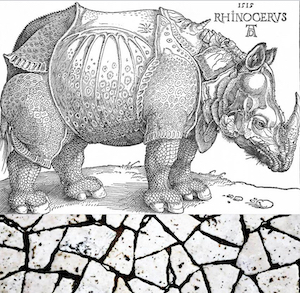
As the museum describes it,
“So as not to muddy the long royal procession in the middle of winter, Ganga and the entourage clothed in fine silks with extravagant adornments from the East processed on the newly-cobbled streets.”
Image Source: portuguesemuseum.org
Those first streets were paved with granite brought in from Porto. That was expensive material, the kind you use to build a road fit for a king … or his rhino.
Most historical accounts date the beginnings of calçada Portuguesa to 1842 when Lt. Gen. Eusébio Furtado had inmates from the Limoeiro Prison pave the parade ground at the Castelo de São Jorge. Furtado designed a zig-zag pattern using black basalt and white limestone.
Image Source: Arquìvo Municipal de Lisboa
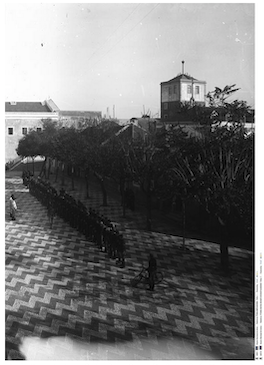
The result was so popular among the citizens of Lisbon that General Furtado was later commissioned to design a cobblestone layout for the Praça de Dom Pedro IV, which is also known as Praça do Rossio or Rossio Square.
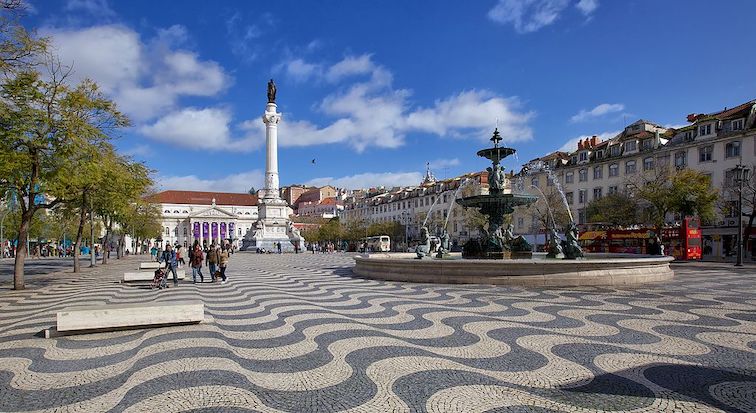
Image Source: commons.wikimedia.org
Furtado’s design, a wave pattern known as Mar Lago (“wide sea”), currently covers over 64,000 square feet. It pays homage to Portugal’s seafaring past and has been widely copied throughout Portugal. The pattern can create optical illusions and is known to make people dizzy and disoriented.
By 1895, calçadas were made mandatory for all new paving projects in Lisbon. From there, the technique spread to other countries in the Portuguese empire and throughout the world.
It’s Practical, Functional, and a Lot of Hard Work
Much of the calçada Portuguesa that we see on a daily basis is simple and functional. According to time-honored specifications for sidewalks and patios, the stones are cut to roughly 4 cm square. They should be set in place no more than 2 mm apart, though in practice there is some variation in size and spacing. (The official Manual Da Calçada Portuguesa, the handbook that spells out everything from how to mine the stone to how to finish it, allows for stones up to 13 cm and gaps of up to 2 cm. All you do-it-yourselfers in the audience will want to download a copy.)
The work is done by skilled craftsmen, known as calceteiros, who traditionally cut the stones by hand. These artisans can create about 110 square feet of plain pavement in a day. In some places, machine-cut stones are also used today.
Once the stones are in place, they are pounded with a heavy wooden tool, called a maço, to ensure they are level. Powdered limestone or a sand and cement mixture is swept into the cracks between the stones and watered down to form a porous mortar.
The video embedded below gives a close-up view of the different steps in laying calçada.
For those of you who want to skip through it, here’s the tl:dr
- At 0:00 – Cutting stones by hand
- At 2:40 – Laying stones – several minutes showing different installations
- At 6:00 – Tamping the stones to level them
- At 6:30 – Applying the mortar
In addition to showing the various techniques, the video gives you an idea of how physically difficult the calceteiros‘ jobs are. Imagine having to crouch or kneel all day, many times outside in the heat and cold.
This type of pavement has several advantages. First, it’s permeable, meaning that water falling on the street can percolate down into the ground, which prevents overflowing the storm sewers.
Second, it’s flexible – the stones can expand and contract as temperatures rise and fall.
Finally, it is relatively easy to repair or to excavate to access buried services like sewer, electricity, and water lines.
It’s Not All Grey Rock
Grey stones – basalt or other harder materials – are often used for sidewalks and some streets. Occasionally white stones will be used to designate a crosswalk.
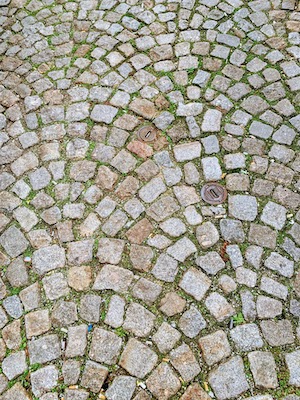
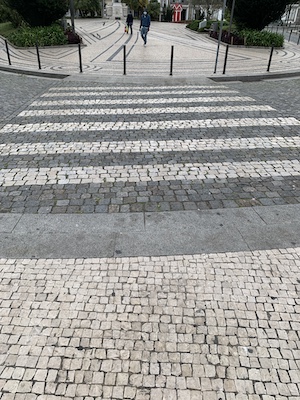
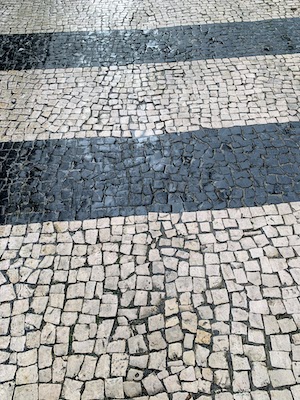
When a decorative effect is desired, the pavers will use colored stones. The most common are black and white limestone, but sometimes there are colored stones mixed in.
The Art Beneath Our Feet
Most of the calçada Portuguesa is plain and functional. Some of it is decorative.
But there are many examples of calçadas as art. Some of the most stunning examples are in Lisbon, like this image of the fado singer Amália Rodrigues.

Warning: The video below might make your heart race or create an intense urge to travel to Portugal.
We have seen some fine examples here in Porto, too, like these on the Rua Sampaio Bruno. This is a one block long street lined with shops and cafés that runs off the Avenida dos Aliados, just north of the Imperial McDonald’s.
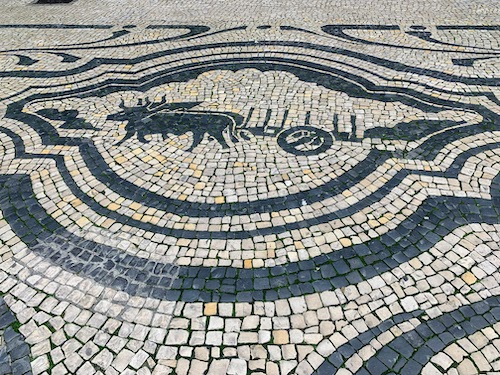
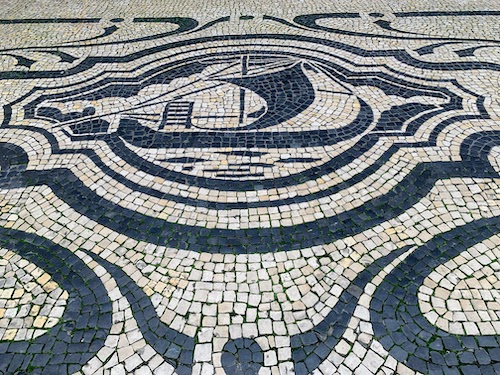
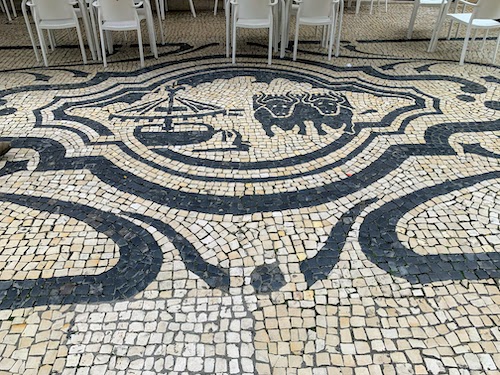
Making these intricate designs often involves a collaboration – an artist will design the pattern and an artisan – the calceteiro – will execute it in stone. Wooden molds are employed to frame the intricate patterns. Stones are laid around the inside edges of the mold. The mold is then removed and the pattern is filled in.
The molds are reusable. The city of Lisbon has over 7,000 wooden molds in storage.
Like artists working in other media, the calceteiros often sign their work by leaving a small symbol embedded in the stone. Jorge Duarte, a master paver who teaches in a trade school in Lisbon, leaves a heart. Other artisans use different signatures.
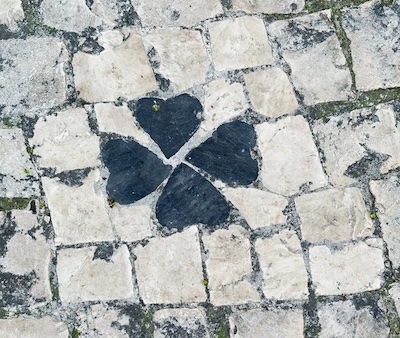
Image Source: The New York Times
The Future is Uncertain
The future for calçada Portuguesa is in question, with several threats to the craft.
First is a shortage of calceteiros, the skilled craftspeople who cut and install the stones and who maintain the finished installations. There are fewer and fewer people in the trade. One report said that in 2018 there were only 10 calceteiros left in Lisbon.
To address the shortage of trained craftspeople, the Escolas de Jardinagem e Calceteiros, the schools of gardeners and stone pavers, was created in Lisbon in 1986. The school trains about 20 students per year. By 2019, the school had trained 224 new calceteiros. Unfortunately, many students have dropped out of the program or left the field for other work that is less physically demanding and which pays better wages. Classes were cancelled one year because only 4 students enrolled.
In addition to a shortage of skilled craftsmen, there is also just the cost of maintaining these handmade pavements. One small town reported they spent about 300,000 euros a year on maintenance and materials. That is a significant cost that many budget-conscious politicians would like to eliminate.
There are also safety concerns. The stones can be slick when they’re wet. They are often uneven due to movement of the earth or traffic. In many cases there are holes where the stones have gotten loose and been knocked away.
All of those factors combine to create an environment where some people are arguing that the stone should be discontinued and replaced with more modern materials. Some even argue that the existing calçadas should be torn up and replaced with other materials.
Conclusion
Calçada Portuguesa, the Portuguese cobblestone, is one part of the historical fabric that exists across Portugal today. We have art beneath our feet, whether we stop to notice it or not. But it is one more thing in the world with an uncertain future.
Because it seems so closely linked to the Portuguese national identity, it won’t go away easily or any time soon. We see new stones being laid and old ones being maintained regularly here in Porto.
There is even a monument in Lisbon that honors the work of the calceteiros.

Image Source: Informações e Serviços Lisboa
All the more reason to get out and see it now.
Where do you see old-time craftsmanship in your area? Tell us a story in the comments below or through a note in the Contact Form.
Watch where you step! / Veja onde pisa!
Mary and Mike
The Cook and The Writer

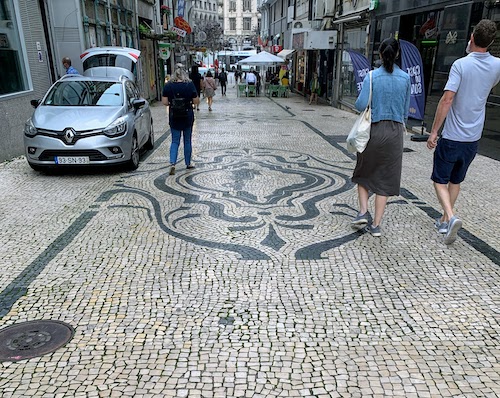

Enjoyed the second reading this morning! It was a joy to see you last evening, friends! Safe travels this weekend!
Hugs and love,
Nan
Loved your piece. It answers a lot of questions I’ve had since arriving here 11 months ago. Very sad to think it is a dying profession, but like so many hand crafts, it is difficult to find people willing to take it on, even after having invested time in learning the trade, given the basic economics. We are gradually becoming a global culture where everything is made by a machine. Hand crafts will become a thing of the past, or an artistic indulgence only the very wealthy can afford.
Great post! Thanks for sharing such great and entertaining info. My wife and I walk past the Monument to the Calceteiros several times a week and we never grasped what it represents until now. Muito obrigado!
What an interesting article!! You are absolutely right about the second video = I am pumped to see this first hand!!!!
Love this post, combining the history with beautiful design & craftmanship… YES I’d love to visit!
Very interesting post!!! I love the Rossio Square pattern!! We noticed similar cobblestone work in Eastern Europe on our last Rick Steves trip, but Portugal has taken it to another level. I can’t imagine tearing all that out and just paving the roads with asphalt or concrete. Sounds like something we’d do in America!! 🙁
Love reading your stories every week. Keep on exploring!!!
I really enjoyed your interesting post and always learn more about the History of Portugal. So much beauty to enjoy there and I appreciate the hard work of the artisans that created the patterns & pavement designs. Looking forward to more of your informative and interesting finds in Porto. Love, Sue
Great article. They actually have similar pavement in Rio de Janeiro Brazil. The pattern of the stone designates the different areas you are in. For example, the Copa Cabana pattern is different from the Ipanema pattern.
I think to take a few hours and to explore the more intricate “pieces of art” in Lisbon would be fascinating.
Thank you for this wonderful post. I remember the beautiful Portuguese cobblestone from my short stopover in Lisbon a few years back.